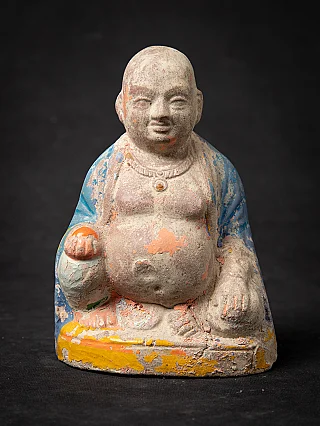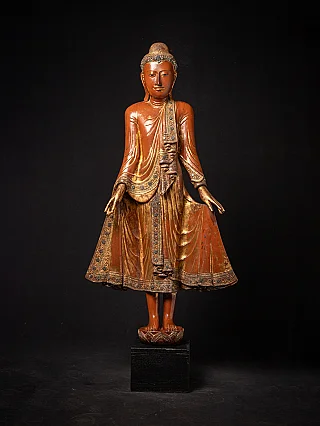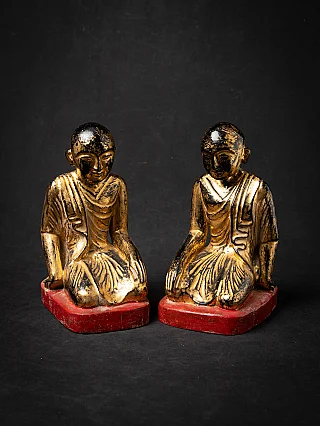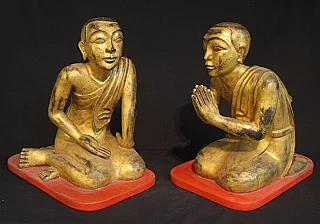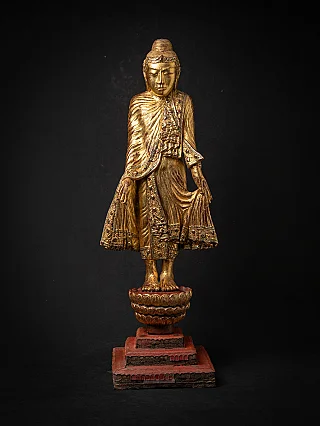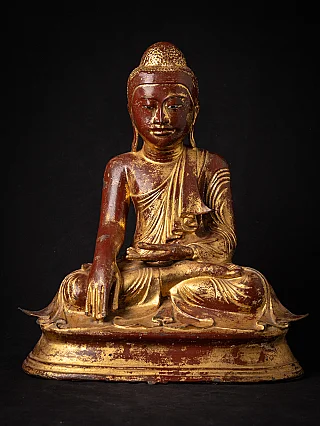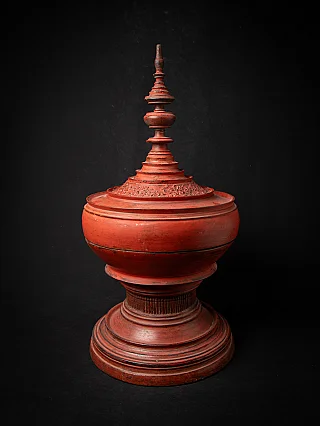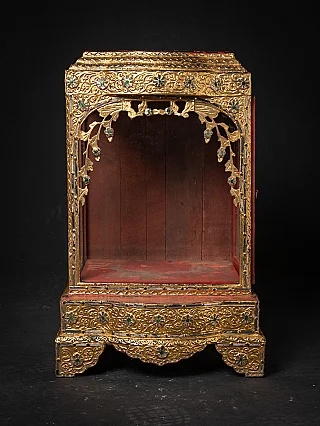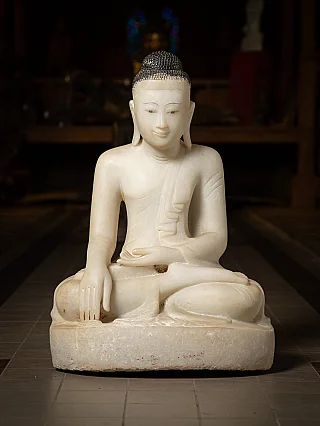The Maha Muni Image and its Rough Path
XU Khin Maung Saw, Berlin

1. Introduction:
Maha Muni Image is a colossal image cast in bronze and inlaid with gold. Hence, this statue became the envy of almost all of the kings of Burma. Whenever they expanded their empire, they tried to rob this holy image. Finally in the year 1784 A.D, the Burmese King Bodawphaya succeeded to annex Arakan into the Burmese Empire and took the holy image.
Here again some Arakanese, headed by U Htun Zan (U Htuan Zan) and U Thande, went to Ava to request the Burmese king to liberate Mrauk U from the incompetent King Maha Thamada of Arakan like the way some Arakanese requested King Min Gaung (Man Khaung) of Ava in 1403 that Min saw Mun (Man Saw Muan) be overthrown. It cannot be ruled out that it was a conflict between the Arakanese from the North and those from the South because Maha Thamada and his predecessor were not from Mrauk U but from Rambree Island.

Believe it or not, according to some Arakanese Chronicles, Alaungphaya (Alomphara) alias U Aung Zeya, founder of the Konbaung Dynasty, the last dynasty of the Burmese kings, was an Arakanese (Rakhaing) prince, whose mother fled the kingdom while she was pregnant because there was a palace revolution at Mrauk U and her husband, the king was killed. The Arakanese Chronicles stated that it was the main reason why Alaungphaya and his sons never invaded Arakan during the reign of Alaungphaya and his two elder sons although Arakan was very weak at that time. It was shown in history that Alaungphaya and his successors invaded and annexed almost all of their neighbors, including the kingdoms of Mon, Siam, Changmai, Langxiang, Assam and Manipur but not Arakan.
Some traditional Burmese historians like Thakin Kodaw Hmaing, U Pho Kyar and Deedok U Ba Cho supported this hypothesis.
When Burmese king Bodaw U Waing sent his son, the crown prince then, to invade the Kingdom of Arakan and to snatch Maha Muni Image, the Arakanese did not resist properly, hoping that the Burmese army headed by the crown prince would overthrow the hated king of Arakan, Maha Thamada and liberate Arakan because the Burmese crown prince was a son of Bodawphaya that means he was a grandson of Alaungphaya, hence, he was also of Arakanese abstraction. Only Maha Thamada's followers resisted. The hope of the Arakanese (Rakhaing) was illusory, however. The Burmese army annexed Arakan and took the Holy Shrine of Maha Muni Image to Ava.
The Burmese Royal Armies looted this colossal image from the Arakan City or Mrauk U after the Burmese conquest of the Rakhaing Kingdom in 1784. They used the Arakanese prisoners of war, about thirty thousand including the last King of Arakan, Maha Thamada, as slave labor to carry that colossal image across the mountain range and for other slavery works like the reconstruction of Meikhila Lake, the aborted war against Siam etc. etc.
After the Burmese conquest, the Arakanese Kingdom was abolished forever. The Burmese totally forgot that they shared the same language, culture and religion with the Arakanese. Their conquest resulted in a complete destruction of Arakan and her people. The Burmese troops had a great amount of savagery in their disposition. Equally distressing was the loss of the national symbol, the Maha Muni Image.
The statue can be seen nowadays in the outskirts of Mandalay. The Burmese called this image Phaya Gyi (Phara Gree) which is the literal translation of Maha Muni. During the British Era, the temple was called ‘The Arakan Pagoda’ by the British.
During the First Anglo-Burmese War many Arakanese helped the invading British armed forces with the hope that they could liberate their country with British help. Apart from that, there was agreement between the Arakanese and the British that the Holy Image would be returned to Arakan. The hope of the Arakanese (Rakhaings) was however, illusory because the statue was never given back to the
Arakanese even after the whole of Burma became a British colony from 1886 to 1947, with the gap of three years Japanese occupation 1942 - 45.
2. The legend
It is believed that the Maha Muni Image was cast at about 563 B.C during the reign of King Sanda Thuriya (Chandra Suriya) of the Dhanyawaddy Dynasty in the presence of Lord Buddha himself accompanied by 500 disciples who were Arahats.
According to the legend, Lord Buddha and King Sanda Thuriya (Chandra Suriya) were bosom friends in one life, while they were cow herds. They were very fond of each other and therefore they left a statue or a picture of the person, when that person had to travel to other place. That’s why Sanda Thuriya (Chandra Suriya) requested Lord Buddha to leave his statue when he had to go back to India and Lord Buddha agreed.
It is also believed that five copies of the Image were also cast and Lord Buddha predicted that the Holy Image (the original) would remain in Arakan for 5000 years.
U San Shwe Bu, on the other hand, wrote: The great outstanding feature in the history of Arakan is the account of Buddha's sojourn in this country and of his supervision over the casting of his image. The story of his seven day's visit with five hundred Rahandas, his lengthy discourse pregnant with prophesy delivered on the top of the hill opposite the town of Kyauktaw, his Journey into the city of Dynnyawaddi at the request of King Sanda Thurya, the casting of the image by men and gods, have been very clearly set forth by the able researches of the late Dr. Forchammer and need hardly be mentioned again in the present sketch. The Mahamuni tradition is the oldest of the kind we have. It permeates the whole religious history of Arakan and the images that at present sanctify a thousand temples and pagodas in this country are the replicas of the first great and only faithful copy of the Master.
Interesting as all these facts may appear there is, however, one great flaw which defies any attempt at reasonable explanation. King Sanda Thurya ascended the throne of Arakan in 146 A.D. all available records are pretty well clear on this point. If we take 483 B.C as the date of Buddha's death there is a very large gap of over six hundred years between the two events, his sojourn in Arakan and his death at Kushinagara. This is quite difficult to explain away and judging from the extreme paucity of documents that treat of those far-away days. I am inclined to think that the problem is one likely to be added to the long list of unsolved riddles of the universe. It is true books belonging to this country have a fatal defect, that they represent facts and beliefs at the time they were written, or acquire the form in which we now find them, without much reference to facts at the time at which they were supposed to have happened. Besides this Burmese books especially bear unmistakable signs of being treated, that is to say, they often take up an important event, enlarge upon it, and then relate how it was prophesied generally by Buddha many centuries before.
View our collection of Buddha statues
In spite of these adverse peculiarities of the East, I entirely agree with the learned Doctor that the Mahamuni Tradition is not an after-thought. It is genuinely old and was implicitly believed in by successive generations that came after it. Kings of Arakan, even after they had shifted their capitals to various other places, always recognized it as a sacred duty to visit it from time to time and generally made it the occasion for great religious feasts of charity. In such cases they invariably left some votive offering, may be a small shrine or an image, as a memento of their distinguished visit.
On the other hand it is not my purpose here to try and reconcile this great discrepancy in time as I am convinced of the utter futility of the task. The very fact that neither Buddha nor any of his five hundred Rahandas who accompanied him into Arakan ever made mention of this unique event in the many subsequent discourses delivered in India is sufficient to tempt one to lay down the pen so far as this point is concerned”.
Here I would like to say, Buddha was Nepali, born in Nepal and made ‘Pre-Nirvanna’ in India.
According to Indian sources, the earliest Buddha statues, paintings and images can be traced back only after four hundred or five hundred years after his death and not earlier. Apart from that some Buddhists believe that Buddha himself had forbidden the production of his pictures or statues for worshipping, instead he recommended to follow his teachings and philosophy, the Dhamma, through his ‘sons’, the Sangha.
In Zinnahta Pakathani Kyam (Jinnatha Pakasani10) written by the Abbot of Kyee Thei Lay Htat Monastery, there is an interesting story, how the ‘God of Destruction’ Maara11 was tamed by the Arahat Uppa Gutta, about 300 years after the Pri-Nirvanna of Buddha.
According to that legend, the Arahat Uppagutta (Shin U Pagote) gave a harsh lesson to the ‘God of Destruction’ Maara (Maar-nat) by hanging a putrid corpse of a dog at Maara’s neck. Since Ahrat Uppa Gutta was mightier than Maara, Maara could not remove ‘his necklace’ for a week. When the ‘God of Destruction’ Maara was tamed and said that Buddha was so kind to him but the Arahats were so cruel, so he wished to become a future Buddha in one of the coming ‘worlds’, however he would never wish to become an Arahat. Then, Uppagutta asked Maara how Buddha looked like, because he had never seen how Buddha looked like and requested Maara to create the image of an ‘Imitation Buddha’. Maara said he could show Uppagutta, how Buddha and his Arahats walking together to receive offerings, however, Uppagutta had to promise him that he should not pay homage or worship those creations and imitations because it was not the real Buddha.
Uppagutta promised. Then Maara created those imitations. Unfortunately, however, Uppagutta forgot his promise and he worshipped those imitations. Then, Maara's body flew like a bullet and hit Mount Meru.
Based on this legend, it has to be concluded that there were no pictures and sculptures of Buddha at that time, otherwise, the Arahat, Uppagutta did not need to ask Maara to create an ‘Imitation of Buddha’.
Not only in the case of the Holy Image Maha Muni, but also in the other Pagoda Legends of Burma, including the legend of the famous Shwe Dagon Pagoda, all of them were constructed while Buddha was alive. In the legend of Shwe Dagon Pagoda, it was also stated that the Pagoda was built by human beings and Devata (Nats) together. We have to consider that in all religions, the legend and the real history are different. Here I would like to suggest: “Let the believers to continue with their own faith and let the historians write their own facts, theories and hypotheses in their own papers or publications.
The readers should decide themselves.
3. The attempts of the Burmese kings to snatch the holy image.
3.1. The First attempt
About the year A.D 1050 King Anawratha (Aniruda) of Pagan invaded Northern Arakan and forced Arakan to become his vassal state. At that time Arakan was ruled by a king of the Pyinsa (Pransa) (Prancha) Dynasty whose name was not mentioned in Burmese chronicles. King Anawratha (Aniruda) wanted to take the Maha Muni Image to Pagan, however, his attempt failed. The Arakanese Chronicles recorded this Invasion as "The king of the Prus came together with ninety thousand Pru soldiers" because the Arakanese called the king of Pagan as ‘Pyu Ta Thein Shin’ (Pru Ta Thein Shan) "The Supreme Commander of one hundred thousand Pru soldiers".12 This was the first attempt of the Burmese kings to snatch the Holy Image, and also it was the first historically recorded contact between the Burmese kings and Arakanese kings.
3.2. The second attempt
Arakanese and Burmese chronicles recorded that the Arakanese king Min Bilu (Man Bilu) was murdered by his minister Athinkhaya (Athankhaya) at A.D. 1068. Min (Man) Bilu's son Min Ye-Baya (Man Ree-Baya) took refuge by King Kyansittha of Pagan and requested the Burmese king to help him regain the throne. However, King Kyansittha was not able to help him, most probably it was more important for the Burmese king to solve ethnic conflicts between the Burmese and their archrivals, the Mons, because there were wars between the Burmese and the Mons during the reigns of his two predecessors, King Anawratha and King Saw Lu. Only in the year A.D. 1104 Min Ye-Baya's (Man Re-Baya's) son Prince Letya Minnan (Latya Mannan), who was born in Pagan City, had succeeded to persuade King Kyansittha's grandson and successor King Alaungsithu. It was also possible that there were no ethnic conflicts under King Alaung Sithu because the king himself was a Mon-Burmese hybrid. So, he could help the Arakanese prince. In this way Prince Letya Minnan (Latya Mannan) regained the Arakanese throne and established the Prem Dynasty.
The Arakanese Chronicles recorded this incident as "The king of the Prus came with one hundred thousand Pru and one hundred thousand Talaings and helped Prince Letya Minnan, the real heir of the Arakanese throne". Alaungsithu tried to take the Holy Image but his attempt too, aborted.
U San Shwe Bu, on the other hand, wrote: “In 1078 A.D. Min Bhi-lu of Arakan was killed by a noble who usurped the throne. Min Re-baya the heir apparent fled with his family and took shelter at the court of Kyan-sittha of Pagan. The fugitive prince remained in exile for twenty five years during which time a son was born to Min Re-baya and is known in history as Let-yar-min-nan. It is true that Kyan-sittha promised to restore the royal fugitive to the Arakanese throne but the lack of suitable opportunity prevented that monarch from redeeming his promise. On the death of Min-Re-baya Alaung-si-thu who had already succeeded his grandfather determined to place Let-yar-min-nan on the throne of Arakan.
To carry out this object he sent 100,000 Pyus and an equal number of Talaings both by land and sea into Arakan. There was some show of stubborn resistance at first which the more disciplined troops of Burma gradually but surely overcame. Thus Let-ya-min-Nan came unto his own in 1103 A.D. and as the Pyus were instrumental in bringing this about he is also known to the Arakanese as the king created by the 100,000 Pyus. When these soldiers had accomplished their task and just on the eve of their departure for Burma they visited the shrine of Mahamuni. There they found it so richly stored with gems and gold that overcoming all religious scruples they began to despoil the temple of all its vast wealth. From the image itself the Pyus scooped out the greater portion of the back, the Talaings cut off the whole right leg and carried away these treasures into their country a distinct fulfillment of Gotama's dicta”.
It has been shown in history that the second attempt of the Burmese to snatch the Holy Image made some damages to the statue because 50 years later, the Arakanese King Datha Raza (Dassa Raja) had to restore all damages caused by the Mons and the Burmese.
3.3. The Third attempt
The military power of Arakan was proven already when Min Bargyi (Man Bargri) conquered back the 12 towns including Chittagong and Tri Pura in A.D. 1532, which traditionally belonged to the Kingdom of Arakan. During his reign the Burmese king Tabin Shwe Htee had re-established the Second Burmese Empire with the help of his warrior brother-in-law General Kyaw Htin Anawratha alias Bayint Naung. They tried to annex Arakan into the Burmese Empire and to snatch the Holy Image, too. General Kyaw Htin Anawratha invaded Southern Arakan; however, their invasion forces were repelled by the Rakhaing forces. Tabin Shwe Htee had to swallow his pride, approached Burmese and Arakanese Buddhist Monks to play the role of peace mediators. The peace treaty was signed by both sides and the Burmese invading armies retreated.
3.4. The fourth attempt
Later, during the reign of Min Phalaung (Man Phalaung)15 (A.D.1571-1593), the youngest son of Min Bargyi (Man Bargri), King Bayint Naung, co-founder of the Second Burmese Empire and the successor of his brother-in-law Tabin Shwe Htee became very proud because he had annexed all of his neighbouring countries including Langxiang and Siam. So, in the year 1581 his armies and navy marched towards Arakan. However, his forces were totally defeated by the Arakanese in all fronts and he was forced to sign a peace treaty. King Bayint Naung was well known in Burmese History Books as ‘the co-founder of the Second Burmese Empire’. He was a pride of the present military government and named him ‘The Founder of the Second Union of Myanmar’.
3.5 The fifth attempt:
Burmese king Bodaw U Waing sent his son, the crown prince then, to invade the Kingdom of Arakan and to snatch the Maha Muni Image in 1784 AD. After the Burmese conquest, the Arakanese Kingdom was abolished forever. The Burmese totally forgot that they shared the same language, culture and the religion with the Arakanese. Their conquest resulted in a complete destruction of Arakan and her people. The Burmese troops had a great amount of savagery in their disposition. Equally distressing was the loss of the national symbol, the Maha Muni Image.
4. Different Versions about Maha Muni Image in Mandalay
There are some different versions about the Maha Muni Image.
4.1. The first version stated that the statue now found in Mandalay is the original one. Many Arakanese and almost all Burmese believe this version. The main reason for the Burmese invasion was to take the Holy Image and since they conquered the whole country, no wonder, they could take the genuine one and many imitations.
4.2. The second version said that the one in Mandalay is merely a copy and the original is still in the caves of the forest near the small town of Kyauktaw in Arakan because the Arakanese noticed that the Burmese invaders might take their Holy Image, and therefore they had hidden the original statue, replaced with a copy just before the Burmese conquest. This statue will reappear one day. During the British Era, some people claimed that they had seen that statue. One had to go through a tunnel behind a Bo tree. U Aung Tha Oo claimed at page 136 of his book published in 1956 that he had been to that tunnel, but he could not enter inside because the roots of the Bo tree had blocked the tunnel. According to him he met a person who had been inside the tunnel and paid homage to that statue in the 1930’s.
4.3. The third version stated, when the Burmese crown prince tried to take the statue on the raft, the statue fell down in the river and disappeared. Hence, the Burmese had to take the copy only. A few years later, some Arakanese found the statue back in the river, carried out from the river and named the statue Phayapaw (Pharapaw) which can be roughly translated as "the re-appeared Buddha-statue". This Statue is now in Mrohaung (former Mrauk U). The new temple was built with its original style and the throne of the former statue (now in Mandalay) could be still seen inside the new Temple.
4.4. The fourth version stated, the original Maha Muni Image is still in Arakan. It is the statue near Kyauktaw because it was hidden in the tunnel near the small town of Kyauktaw before the Burmese invasion armies reached Mrauk U. This is statue near Kyauktaw looks exactly like the statue in Mandalay; however, it has the size of a normal human being.
Some Arakanese believe, one of the latter versions must be true. Their reason is: "Lord Buddha himself had predicted that his image should stay in Arakan for five thousand years and the past history has proven already that the attempts of King Anawratha, King Tabin Shwe Htee as well as King Bayintnaung of the First Burmese Empire and the Second Burmese Empire respectively had failed, so, why the attempt of the king of the Third Burmese Empire should not also be failed". They argued, Buddha was born and died as a normal human being with a normal human body, but he attained Enlightenment and became Buddha. The statue in Kyauktaw has the size of normal human being. The one in Mandalay however, is a colossal image.
4.5. U San Shwe Bu’s version
“In the closing scene of its variegated history Bodawpaya of Burma comes in, a fit character for a fit occasion. After his final conquest and so- called pacification “solitudinem faciunt pacem appellant” he directed the famous image to be conveyed into Burma. This was accomplished in the year 1785 A.D. The excess of patriotic fervor led some people a few years ago to declare that the real image was lost in the creek close to the site in the course of its removal and that the soldiers fearing the king’s wrath took away a substitute. Attractive as this country proclaims the image that now adorns the Arakan pagoda at Mandalay to be the genuine one”.
Whether the statue in Mandalay is the genuine Maha Muni Image or not, the pride of Arakan was degraded and almost all Arakanese consider it as a robbery. Even now, two centuries later, some
Arakanese, particularly from Northern Arakan occasionally named the Burmese as Phaya Damya (Phara Damra) “Thugs of the Buddha Statue”.
5. The Restoration of the Holy Image
Whether the Holy Image was cast while Buddha was alive or made only in second century AD as U San Shwe Bu stated, it was sure that after the sacred image was finished it was suitably installed. The Holy Image was undisturbed for a period of over nine centuries between 2nd to 11th Century AD. During that time it became the religious centre of the kingdom and all its neighboring states. Hence, this statue became the envy of almost all of the kings of Burma. Whenever they expanded their empire, they tried to rob this holy image.
5.1. King Datha Raza’s (Dassa Raja) contribution
On his astrologers’ advises that the city of Pyinsa (Pransa) was no longer fit for occupation because all its good fortune had departed, Let Ya Min Nan (Lat Ya Man Nan) built the new city of Parin (Prem) (Puremma). Fifty years later King Datha Raza (Dassa Raja) ascended the throne. The new king was powerful and just and the country enjoyed general peace and prosperity. Following the example of all his predecessors he decided to pay homage to the Maha Muni Image. He sent some Ministers in advance to make the necessary preparations for his stay there.
Unfortunately, however, these Ministers returned back and informed the king that the temple could not be found. The King Datha Raza then entrusted these men with his personal jewels and instructed them to reward any person who could direct them to sacred spot. At the beginning, it was not easy for the ministers to find a guide. Finally, with the assistance of two Mros they found the place. These men were rewarded as ordered by the king.
When news of the discovery of the Holy Image was informed, the king immediately set out for the place with his entire court. The Holy Image was found in the ground buried up to the neck. The right leg and the greater part of the back were missing. The shrine was completely destroyed by fire.
The king at once saw the exposed nature of the place. He knew that its general isolation among the hills was the frequent cause of the shrine being desecrated by some tribes who made periodic visits of plunder into these parts. He decided to take the Holy Image to the capital city just to avoid those problems in the future. He transported the Holy Image by water way into the ancient city of Dhanyawaddy. According to the chronicles, the invitations were sent to all the neighbouring kings, dukes and princes to visit Arakan and share with him the supreme merit to be acquired by undertaking the entire repairs of the most sacred image and shrine. The gathering of ruling monarchs, dukes and princes was a representative one. Firstly they had to repair the Holy Image by reconstructing the missing parts. Then they had to erect the shrine on which all their skill, energy and resources. All races presented there, shared the building of the surrounding walls. Thus, some were given duties to carry out the work on the east of the shrine, some to the west, some to the south and so on. The temple and the walls were decorated with exquisite carving. The latter contained human figures representing all the races of the earth, as traditional belief of 101 races, namely the seven races of Mramar, the four races of Mons, sixty races of Kalas (in modern belief Indo-European tribes) and the thirty races of Shans (in modern belief Mongolian tribes). There is no doubt that this second building of the Maha Muni was a great historic event. The historical site, though little is left at the time of U San Shwe Bu’s survey, is the evidence.
The spot selected was a small hill at the north east corner of the royal city. The relics and gems buried by king Sanda Thuriya (Chandra Suriya) were also unearthed, removed and buried again at the northern end of this hill. The stone slab placed on the mouth of the pit was so heavy that one thousand men could not even be sufficient to shift it from the place, so stated in the chronicles. Believe it or not, the chronicles stated that the whole work was finished within seventy one days. After finishing the restoration, all races and tribes subjected to the King of Dhanyawaddy were given duties to visit the temple once in every three months for the purpose of carrying out such minor repairs as were considered necessary from time to time. But some of the tributary tribes were given definite work and special duties to perform. They were required to guard the place always. The details of the allotment of such specific duties were also recorded in stone tablets at the four cardinal points.
U San Shwe Bu, who was an officer at the Archeological Survey Department, recorded in 1918, almost 100 years ago, that those records could not be found in their usual places though he was told by an authority, whose name he did not want to mention, that they were still there.
5.2. Restoration and maintenance of the Holy Image
There is no doubt it became the tradition and duty of each and every Arakanese Monarch to pay homage to the Maha Muni as well as to restore and maintain the shrine and premises because some mountain tribes occasionally tried to plunder. Here I would like to cite U San Shwe Bu: “It will be seen that the present account deals with the principal events only. But it must not be supposed that during the long interval between these epochs the image and the shrine were allowed to remain in peace. The frontier tribes such as the Chins, the Mros and the Saks periodically descended from their mountain homes and harassed the kingdom whenever it was known the ruler of the country was weak or incapable. On such occasions they always made it a point to visit the shrine and after taking away all the riches it contained they invariably set fire to it. Whenever this happened the then reigning king would forthwith rebuild it and make good the loss. In the chronicles this occurs with painful regularity.”
5.3. The Holy Image during the Mrauk U Dynasty
The holy shrine and premises were well protected by the kings of the Mrauk U Dynasty because all kings were devoted Buddhists though some of them bore pseudonym Muslim Titles. Some of them cast reproductions or duplicates of this Holy Image and these imitations were put in the temples and pagodas donated by them.
This Statue was taken to Mrauk U. The new temple was built in its original style.
When Min Phalaung (Man Phalaung) died in 1593, his son Razagyi (Razagri) succeeded the throne
(1593-1612), and the military power of Arakan reached its peak. This time, the Arakanese armies could invade, occupy, plunder and destroy Hanthawaddy or Pegu, the capital of the Second Burmese Empire. They took the daughter of the Burmese Emperor, Cambodian statues and white elephants which the Burmese had taken as booty from Siam a few years ago. These statues were originally taken from Angkor Wat to Ayuddiya by the Siamese as booty after they annexed Cambodia centuries ago. These statues were kept in the premises of the Maha Muni shrine. Later in 1784, after the Burmese conquest of Mrauk U, these statues were taken to Ava as booty and till now they can be seen in the premises of Maha Muni Pagoda near Mandalay.
Here I would like to cite Maurice Collis: "The Arakanese invasion of Burma in 1599 during the reign of Bayin-naung's successor, Nandabayin; ruined that country for the time being. It broke up into petty states. All Bayin-naung's glory passed to Razagri. Possessing the white elephant and the Maha Muni, he had a right to call himself the champion of Buddhism. Arakan, not Burma, became the centre of the Buddhist world. --- By 1610 Bayin-naung's grandson, Anaukpetlun, had again united the greater part of the country. He was most anxious to get back the white elephant, and in 1616 proposed to the Viceroy of Goa a joint attack on Mrauk-u, declaring that if he secured the animal the Portuguese could take the rest of the loot. But the proposal came to nothing. Arakan was too strong."
Again, Maurice Collis described about the situation of Buddhism in the year 1630 during the reign Min Hayi (Man Hari) alias Thiri Thudhamma (Sri Sudhamma). In his book The Land of the Great Image in page 168 it was written: "The Buddha had died in 543 B.C. Altogether 2173 years had elapsed since then, and for that immense period the image of the Founder of the Religion had remained on Sirigutta, the oldest, most mysterious, the most holy object in the world. The relics detailed to the disciples on Selagiri had all been found and enshrined. Arakan was a sacred country; it was the heart of Buddhism; and he (King Thiri Thudhamma) as its king, was the most notable Buddhist ruler in existence. Grave indeed was his responsibility. He had not only to maintain the state as the homeland of the Arakanese race, but as the one place on earth where an authentic shape of the Tathagata was preserved, a possession of greater potency then the most precious relics".
6. Maha Muni Image in Burmese Hands
After Bodaw U Waing’s son took the statue to Ava, not like their predecessors during the Pagan. Dynasty, who cut and took some parts of the image, the Burmese king built a huge temple for the holy Image. The statue can be seen nowadays in the outskirts of Mandalay. The Burmese called this image Phaya Gyi (Phara Gree) which is the literal translation of Maha Muni. Whenever the temple was damaged by fire or natural catastrophes they repaired it immediately.
While the last king of Burma, King Thibaw and Queen Supaya Latt were taken by the British to exile, they requested the British officers to grant them permission to pay homage to the holy shrine, however, their request was turned down by the British officers because they feared that the crowd would snatch the king and queen.
During the British Era, the temple was called ‘The Arakan Pagoda’ by the British.
At the beginning of the Second World War, the British could not alone defend against the Japanese invasion and asked the Chinese for help. Chaing Kai Shek sent two Chinese divisions to defend against the Japanese invasion. These Chinese soldiers during their retreat to China wanted to rob and melt the Image which was full of gold and jewels. Many thousands Buddhist monks in Mandalay came out with bamboo sticks, guarded the holy Image and surrounded the temple premises and told the Chinese Ku Ming Tang soldiers that they had to kill the monks before they could enter the temple.
Finally, the officers ordered their soldiers to retreat. Nowadays there is an Abbot with many monks who take care of the temple and Holy Image. The monks give early offerings to the Holy Image. In addition there is a ceremony of washing the face of the Holy Image, done personally by the abbot, at about 5:00 AM daily. Both became traditions so that many Burmese in Mandalay and Shan pilgrims from the highland go and watch this ceremony.
There were rumours that some generals of the present military junta wanted to steal some gold and jewels from the Holy image and wanted to open the belly of the statue where the relics were stored. Many monks did not tolerate it and therefore some monks were arrested and disrobed.
Burma is the land of rumours and some rumours are true and some are not true. It is not because the people are gossip and rumour mongers, it happens because there is no press freedom in Burma since 1962 and all newspapers as well as Broadcasting and TV stations are state owned. All news and publications are censored. There are some but very few private owned journals and magazines, however, the editors have to submit novels, articles, jokes, poems, cartoons etc. etc. to the censorship board called ‘Sarpay Sisityay’ and only after getting permission from this board, the editors can publish them. Hence, it is no wonder that the news media totally depends on rumours.
There were some rumours in the past too. An earthquake in Rangoon in the early 70’s caused some minor damages in ShweDagon Pagoda. The Umbrella full of gold and jewels worth 35 million US Dollars at that time, donated by King Mindon, had to be repaired. Rumours came out that Daw Khin May Than, the wife of the then dictator General Ne Win had snatched some of them. A year later she died of a minor operation in London and many people believe that she had to answer a curse. Who knows?
Again in the mid 70’s there was a strong earthquake at the ancient city of Pagan and many ancient temples were destroyed. The rumours came out again that the authorities had stolen antiques. Nobody knew whether it was done by the authorities or by people living nearby or the re-construction workers, later many of those antiques were smuggled out from Burma to Thailand. Many Burmese antiques fill Thai antique shops up to now.
During the Second World War, the Botahtaung Pagoda was hit by allied bombing and destroyed. The rumours came out that, the then Adipati or Chancellor of Burma, Dr. Ba Maw and family had taken the Diamond-Bud of the umbrella. Nobody knows, whether it was true or not. Later, after the Japanese surrender, Dr. Ba Maw was arrested by the Americans and put into jail in Japan for trial. However, he was lucky because the British bailed him out from the Americans to counter balance the power of General Aung San who became very popular in Burma. In any case, there was no come-back for Dr. Ba Maw until his death in 1977, although he and his party participated in 1952 and 1956 elections.
According to Burmese Buddhist belief, he/she who steals the properties or relics of a temple or a monastery, that person as well as his/her collaborators had to reap the consequences of their misdeeds. Either in this life or after death they have to suffer an unlimited period in Maha Awizi (Maha Aviji), the deepest of all hells or Narat. Despite of that belief, as in the proverb, ‘The hungry stomach cannot make a good politician’, some Burmese plundered and plunder the antiques and relics from Pagodas and temples, smuggled these out of Burma to Thailand. This is really a tragedy and shame!
7. Conclusion
As I have written earlier, whether the Holy image was made in 563 BC in the presence of the Lord Buddha and his 500 disciples or cast only in 2nd century A.D as U San Shwe Bu pointed out, this was not my main point in this essay. I would like to say that not only in the case of the Holy Image Maha Muni and many of the Pagoda Legends of Burma but also in all religions, legends and real history are different. It is to point out that the Holy image went through many centuries of ups and downs depending on the strength of the ruling monarch of Arakan until 1784 and that of the Burmese rulers after 1785. Some parts of the Holy Image were either robbed or destroyed and later replaced by the new donor.
In the same way, the present author wants to emphasize that whether the statue in Mandalay is the genuine Maha Muni Image or not, and although the Burmese reveres the statue, Arakanese pride has been degraded and thus most of them consider it as a robbery. Even now, more than two centuries later, some Arakanese, particularly from Northern Arakan occasionally name the Burmese as Phaya Damya (Phara Damra) “Thugs of the Buddha Statue”. Almost all Arakanese whether from the north or the south, are distressed by the loss of their national symbol, the Maha Muni Image.
Share this page




















